Written by: Kelsey Downing PT, DPT
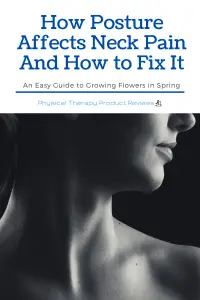
When we were younger our parents always told us to stand up straight. At the time it just seemed like nagging, but what if those words were really setting us up for a pain-free life? Posture plays a big role in how the body functions, and in today’s world we look down at our phones and sit for hours at a computer, creating a habit of poor posture. This habit is causing postural muscles to overwork, creating inflammation, and possibly referring pain to the neck and shoulders.
Lifestyle Modifications for Neck Pain and Posture
So what can you do to change this habit and possibly treat that ongoing neck pain you have been suffering from. Here are a few suggestions.
Ergonomics
If you spend long periods of time sitting at a computer, it’s imperative that you take some time to set up your workspace. When sitting at your desk, you should set up your monitor to be directly at eye level so you can keep a neutral position in the neck. If you can’t do that at your current work station you might benefit from Standing Desk Converter to change the height or stand throughout your day. Your arms should rest at the side of the body, with a 90-degree elbow bend to reach the keyboard. Lastly, think about your work chair. Your chair should offer ample back support and fit the natural curve of the spine and allow your feet to be flat on the ground.
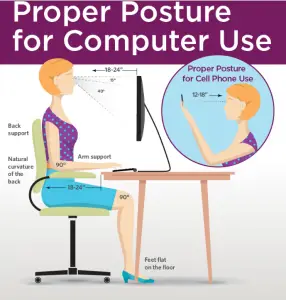
Use these tips when using your cell phone, tablets, or e-readers and you can start to feel the improvements in your posture and maybe see a change in that pesky neck pain.
Catching Z’s and Sleeping the Right Way
Do you ever wake up with a stiff neck that lasts all day? Next time you hit the hay try changing the position in which you sleep. First, limit the plushy pillows. When sleeping you want to keep the spine straight. Putting a bunch of pillows under your head tilts your spine and causes strain. This also means you should skip the soft mattress and pick a firm mattress that holds your spine’s natural shape. Lastly, if you are a stomach sleeper, try to be adamant about changing this habit. Stomach sleepers tend to rotate their head to one side, putting a great strain on the muscles and joints of the neck. Opt for sleeping on your side or on your back.

Exercises for Better Posture
The most important thing you can do to change your posture is to exercise. Working on lengthening those tight, overworked muscles and strengthening those underused muscles is the best way to improve your posture. Try adding these exercises to your routine and see what changes you notice.
Shoulder Pinches
This exercise can be done sitting or standing. Start by bending your elbows to 90 degrees, with the palms facing inwards. Start to draw your elbows back behind you and squeeze your shoulder blades together. Think about pinching a pen between your shoulder blades to get the best engagement. Hold for 10 seconds and return to start. Repeat 20 times.
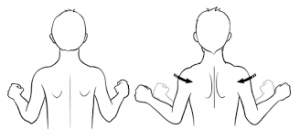
Neck Circles
Either sitting or standing, start in a neutral position with the neck, with your gaze straight ahead. From here gently start to tilt your head to the right, feeling a stretch on the opposite side of the neck. With control, roll your head towards the back of the room with your eyes facing up to the ceiling. Then start to roll to the left side, feeling the stretch on the right. Then end the circle, bringing your chin down towards your chest. Continue this circle 5 times and then do 5 more in the opposite direction.
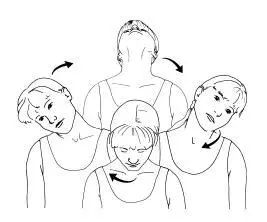
Doorway Pec Stretch
Standing in an open doorway, bring each arm up onto the door frame with your elbows bent at 90 degrees. Slowly start to step forward with one foot and you should start to feel a gentle stretch on the front of the chest and shoulders. Hold for 30 seconds, then step back and relax. Repeat 3 times.
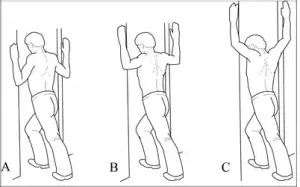
Doorway Pec Stretch
Standing in an open doorway, bring each arm up onto the door frame with your elbows bent at 90 degrees. Slowly start to step forward with one foot and you should start to feel a gentle stretch on the front of the chest and shoulders. Hold for 30 seconds, then step back and relax. Repeat 3 times.

Thoracic Trunk Rotation
For this exercise come down onto the floor and lie on your right side, bringing both arms straight out ahead. With the left arm, start to move across your body and towards the left side of the room. Hold here for 5 seconds and then return to start. Do this move 10 more times and then do the same on the opposite side.
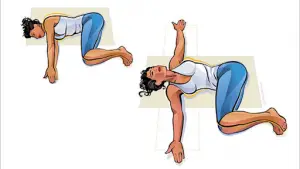
Chin Tuck
This exercise is best completed on the floor. Start with the neck in a neutral position, with your gaze going up towards the ceiling. From here think about pushing the small of your neck towards the ground. Think about creating a double chin to help you get the position correct. You should feel the muscles on the front of your neck start to engage. Hold for 10 seconds and repeat 5 times.
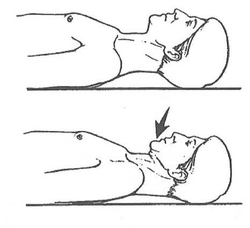 Attempt to listen to those words of your mother and work on your posture. By changing this one thing you may see some changes. Your neck pain may start to dwindle, you may be able to look over your shoulder a little farther, and you might even feel a little taller. Use your posture to your advantage, and use these tips to help you get out of pain.
Attempt to listen to those words of your mother and work on your posture. By changing this one thing you may see some changes. Your neck pain may start to dwindle, you may be able to look over your shoulder a little farther, and you might even feel a little taller. Use your posture to your advantage, and use these tips to help you get out of pain.
Written by: Kelsey Downing, PT, DPT
Kelsey Downing earned her Doctor of Physical Therapy (DPT) degree in 2016 from Campbell University in Buies Creek, NC. Since then, she has been working in a variety of settings. From outpatient, acute care, and home health she has gained a wealth of hands-on knowledge. Additionally, she has sought out further certification in manual therapy, concussion management, and lymphedema management. She continues to be driven to learn and refine her skills to improve patient care. Pt is a frequent contributor to physicaltherapyproductreviews.com.
Work Cited
Bubnis, Daniel. (2018, July). 12 Exercises to Improve Your Posture. Retrieved from
https://www.healthline.com/health/posture-exercises#high-plank
Cleveland Health Clinic. (2018, December). Poor Posture Hurts Your Health More Than You Realize: 3 Tips for Fixing It. Retrieved from https://health.clevelandclinic.org/poor-posture-hurts-your-health-more-than-you-realize-3-tips-for-fixing-it/
UPMC Health. (2014, May). Improve Your Posture: How to Sit at a Computer. Retrieved from https://share.upmc.com/2014/05/desk-posture-q-and-a/
Pictures Cited
Sleeping Positions for Back and Neck Pain
Exercises to Relieve Neck and Shoulder Pain
Expert Answers: Safe Rotational Exercises
chin tuck supine
Other Great Rehab Related Articles
How to Stay Active After Cervical Fractures: Expert Tips and Advice
Dealing with Painful Stairs After Ankle Replacement Surgery
Walking After a Total Ankle Replacement: Tips for a Successful Recovery
Exercises While Non-Weight Bearing After Ankle Replacement: Elevation, AROM, Leg Raises, and More
Ankle Pain with Stairs: Causes and Home Treatment Options
5 Common Mistakes You’re Making After an Ankle Sprain
Disclaimer: The information provided in this post is for educational purposes only. This is not a substitute for a medical appointment. Please refer to your physician before starting any exercise program.







